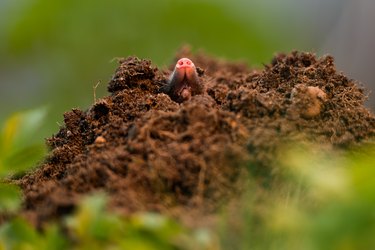
Mice, chipmunks, voles and moles are all pests that can get into houses and sometimes cause damage and spread disease. Moles are known to dig up yards, but a house mole is a rare occurrence. Unlike mice, moles are not rodents; they are little mammals. While it is unusual for them to come indoors, they can find their way in through small and large openings.
How Can Moles Get in Your House?
Video of the Day
Moles are strange-looking, small mammals with poorly developed eyes and overdeveloped, sensitive snouts. These mammals have a powerful sense of touch and long claws that they use to dig tunnels. The star-nosed mole has 22 tentaclelike protrusions on its snout, making it six times more sensitive to touch than human hands. Moles usually aren't more than 10 inches long and can be black, gray, orange, white or cream-colored, or they may have colored patches with dense fur that often sticks straight up.
Video of the Day
Moles aren't blind, but they are colorblind and don't see well. Most live in grasslands, wetlands, woodlands, meadows and riverbanks, but some live in desert regions. They are generally very effective at tunneling and can burrow through 160 feet in one night at about 15 feet an hour. Although it doesn't happen that often, they can get inside through foundation cracks near soil lines, damaged basement windows and other openings. Landscapers don't like moles, and sometimes, their work can drive moles toward buildings.
There's a Mole in My House
Moles are generally harmless creatures, but they can cause property damage in lawns. Their tunnels can cause more weeds to grow, make grass grow too fast and erode root systems. These tiny pests also leave molehills, which look like small piles of dirt all over the ground that are more prominent than anthills.
It is highly unusual for a mole to come inside a house, so if you think you have a mole in the house, it might be a rodent or another small animal. Moles have almost nonexistent eyes and ears, noticeable snouts, small hind feet and large forefeet with claws. If you happen to see one in your house, there's no need to panic. Just open the door and it will most likely leave on its own. If you think you have moles in walls, you should note that they cannot climb. If you hear these kinds of sounds, it's probably mice or rats.
Keeping Moles Away
Do moles come into houses? They only enter houses on infrequent occasions, and there are ways to repel them both indoors and out. They dislike red pepper, coffee grounds, cayenne pepper and cat litter, so you can sprinkle these on the ground where you see mole activity. Moles also hate the smell and taste of castor oil, so you can combine three parts of this with three parts of water and one part dish soap. Pour this into a spray bottle and spritz it near molehills and tunnels.
These pests also stay away from certain flowers, like daffodils and marigolds. Granular repellents that contain castor oil and cinnamon are also effective at repelling moles. There are also nonlethal sprays on the market, and the active ingredient in these is castor oil. You can also find humane mole traps that don't kill these animals and are safe to use around children. Many homeowners succeed with ultrasonic spikes, and these don't use toxic ingredients or traps.
- University of Connecticut: Field Rodents: Mice, Voles, Chipmunks, and Moles
- Critter Control: How to Get Rid of a Mole in Your House
- National Wildlife Federation: Moles
- Live Science: Moles: Habitat, Habits and Conservation
- Mick's Exterminating: Is There a Mole in Your House? Investigate!
- MyMove: How to Get Rid of Moles and Keep Them Away for Good
- Rid-A-Mole: Most Frequently Asked Questiosn
- Lawn Care Academy: Lawn Moles and Voles How to Get Rid of Them
- Science Daily: Mole